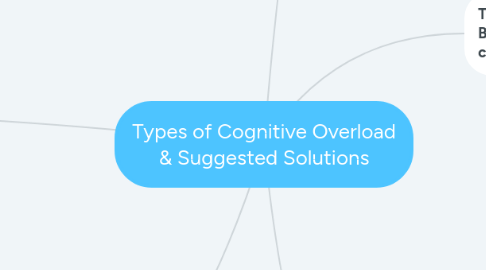
1. Type 1: Intrinsic processing in visual channel > cognitive capacity of visual channel
1.1. Solution: Offloading. Move some processing intrinsic processing to auditory
1.1.1. Modality effect: transfer is improved when words are presented as narration rather than text
2. Type 2: Intrinsic processing in BOTH channels > cognitive capacity
2.1. Solution A: Segmenting. Break learning into smaller pieces and allow time to process each one.
2.1.1. Segmentation effect: transfer is improved when learner controls pace of segments instead of presentation as 1 continuous product
2.2. Solution B: Pretraining: Provide pretraining to prime learners to form foundational sub-schemata
2.2.1. Pretraining effect: transfer is improved when students know names or characteristic of individual components of systems
3. Type 3: Intrinsic processing + extraneous processing (caused by extraneous content/seductive detail) > cognitive capacity
3.1. Solution A: Weeding. Eliminate interesting but extraneous material not directly related to learning goals.
3.1.1. Coherence effect: Transfer is improved when extraneous material is excluded.
3.2. Solution B: Signaling. Provide cues to focus learner attention on relevant details
3.2.1. Signaling Effect: transfer is improved when signaling of important details is used
4. Type 4: Intrinsic processing + extraneous processing (caused by confusing presentation) > cognitive capacity
4.1. Solution A: Aligning. Keep related text + images close together to reduce need to split attention
4.1.1. Spatial contiguity effect: Better transfer when text is placed near related graphics
4.2. Solution B: Eliminate redundancy: Avoid identical information in narration and text
4.2.1. Redundancy effect: Transfer improved when words are presented as narration rather than both narration AND onscreen text
5. Type 5: Intrinsic Processing + Representational Holding (working memory processing) > cognitive capacity
5.1. Solution A: Synchronizing. Narration and animation are synched rather than successive.
5.1.1. Temporal Contiguity effect: transfer improve when animation + narration are simultaneous.
5.2. Solution B: Individualizing. Match multimedia instruction to high-spatial ability learners
5.2.1. Spatial ability effect: transfer is improved for high spatial ability learners compared to low spatial ability learners

